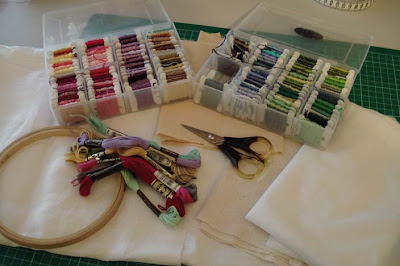Lisa J, one of the lovely ladies who comments here, asked if I would give some instructions for doing stitcheries. I'm happy to do that as stitchery can be used to make a wide range of gifts for the people in your life and for beautiful things in your own home. It's a great skill to have.
These are the fabrics I use. On the left is a white cotton and the right a beige linen.
I always draw my own designs because I like to customise my gifts for my friends, but there are free patterns on the web and I have some here for free down load. You can also buy patterns at the craft store. If you can draw, try doing your own design. They don't have to be perfect because stitchery should have a handmade look. The appeal of stitchery is that it's not like mass produced embroidery.
Once you have your pattern, which is usually just a piece of paper, you need to transfer it to your fabric. I just pin the pattern to the back of the fabric and trace it onto the fabric with a dark soft pencil. Here are some instructions on how to transfer a pattern. How to transfer the pattern to your fabric.
Once you have transferred the pattern and attached the backing to the fabric, you'll need to work out your colours and prepare your threads. You will start in the centre and work your way outwards, so choose a colour for the centre and thread your needle with two strands of thread about 75 cm long. The needle you use should be the finest needle you can manage to thread. Pull the thread through the eye of the needle so the thread closest to the eye is doubled (4 strands) and the end of the thread, the thread that will be in your fabric, is single (two strands). Now you're ready to start. You can use an embroidery hoop if you like. I don't like working with a hoop but many stitchers do.
Most of the stitches you'll do will be back stitch. This makes up about 90% of your stitches. Here are some instructions: How to do back stitch. And here are some photos of me starting a back stitch. Start under the fabric.
And following along in a straightish line. Pull each stitch firmly but not tightly.
Here are three stitches completed. Try to keep your stitches to an even length.
So you just follow your pattern with back stitch, from the centre out and when you need to do dots, like in the pattern below, they are colonial or French knots. How to do a colonial or French knot. The leaves, or to make a flower, are detached chain or daisy stitch How to do detached chain or daisy stitch.
Instructions for other stitches.
Tutorial for using finished stitchery.
I hope these instructions help get you started as you can make gifts for women, men and children with stitchery and a bit of know-how.






